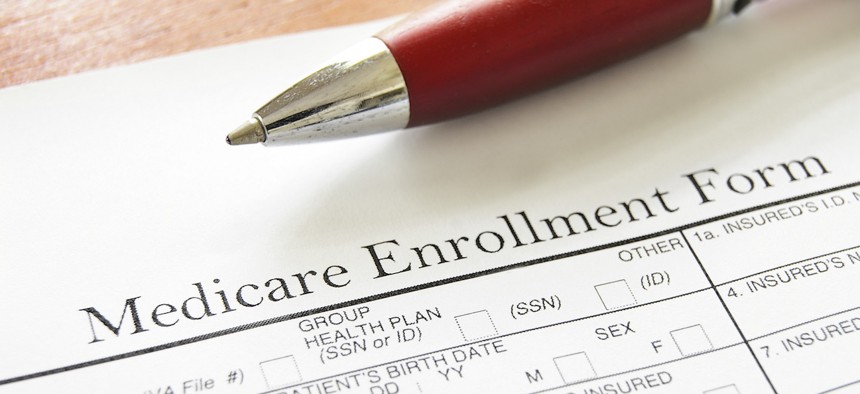
zimmytws/Getty Images
What federal employees need to know about Medicare enrollment
An updated guide to timing, parts, costs and coordination so you don’t get stuck with penalties or surprises at 65.
Most federal employees and annuitants know they are eligible for Medicare benefits at age 65. What’s less clear is how and when to enroll in the different parts of Medicare. Here’s what to keep in mind as you approach eligibility.
1. Initial Enrollment Period (IEP)
If you are not receiving Social Security or Railroad Retirement Board benefits when you near age 65, you can enroll in Medicare starting three months before your 65th birthday month and up to three months after. That’s your initial enrollment period.
If you enroll during the first three months, coverage begins in your birth month. If you enroll in your birthday month or in the last three months of the IEP, coverage starts the following month.
2. Medicare Part A (Hospital Insurance)
Part A is available to people who are 65 or older, those with disabilities, and those with end-stage renal disease. To qualify for premium-free Part A, you must have earned enough quarters of coverage through your own or a spouse’s, parent’s, or child’s Social Security record.
If you are not already receiving Social Security or Railroad Retirement Board benefits, you will need to file an application for Medicare by contacting the Social Security Administration at 1-800-772-1213 or through ssa.gov/medicare.
CSRS employees paid only the Part A portion of the FICA tax. Their quarters of coverage count toward premium-free Part A but not toward Social Security retirement benefits.
The number of quarters required depends on whether you qualify by age, disability or end-stage renal disease. Most workers who pay full FICA taxes earn quarters that count toward both Social Security benefits and premium-free Part A.
If you begin receiving Social Security at least four months before turning 65, you do not need to apply separately — you will be automatically enrolled in premium-free Part A. Coverage starts the month you turn 65 if you apply for Part A or Social Security within six months of that month. If you wait longer, coverage is retroactive for six months.
If you are 65 or older and not yet receiving Social Security retirement benefits, you can delay enrolling in all parts of Medicare if you want to keep contributing to a health savings account under a high-deductible health plan.
Note: If your 65th birthday falls on the first day of the month, Parts A and B coverage begins on the first day of the prior month. For example, if your birthday is Dec. 1, your coverage starts Nov. 1.
3. Medicare Part B (Outpatient or “doctor’s insurance”)
You can only sign up for Part B during certain enrollment periods. If you do not enroll when you are first eligible, you may have to pay a permanent late enrollment penalty.
If you are already receiving Social Security benefits, you will be automatically enrolled in both Parts A and B starting the first day of the month you turn 65 — or, if your birthday is the first day of the month, the month before.
If you are under 65 and have a disability, you will automatically get Parts A and B after receiving Social Security disability benefits for 24 months. You will also get automatic enrollment if you receive certain Railroad Retirement Board disability benefits or if you have ALS — in that case, Parts A and B begin the month your disability benefits start.
4. Premiums for Medicare Parts A and B
Part A is financed by payroll taxes — 1.45% from the employee and 1.45% from the employer. Self-employed people pay both shares, or 2.9%. Because you have already paid these taxes, there is usually no monthly premium for Part A.
Part B is funded mainly by monthly premiums, which are deducted from Social Security benefits or paid directly if you are not yet receiving them. Details on payment methods are available at medicare.gov.
The standard Part B premium is projected to rise to $206.50 per month in 2026, up from $185.00 in 2025. Beneficiaries with higher incomes may pay more through the income-related monthly adjustment amount, or IRMAA. For 2026, individuals with 2024 modified adjusted gross income above $109,000 (or couples filing jointly above $218,000) will pay the surcharge.
5. General Enrollment Period (GEP) for Part B
If you do not enroll during your initial enrollment period, you can sign up between Jan. 1 and March 31 each year. Coverage starts the first day of the month after you sign up.
A late enrollment penalty may apply for as long as you have Part B — your premium increases 10% for each 12-month period you were eligible but did not enroll.
6. Special Enrollment Period (SEP)
If you are covered by an employer group health plan through current employment — yours or your spouse’s — you can delay enrolling in Part B without penalty.
You can enroll any time while covered under that plan or during the eight-month window that begins the month after employment or coverage ends, whichever comes first.
7. How Medicare coordinates with FEHB and PSHB
Under the new Postal Service Health Benefits program, if you are under age 64 on Jan. 1, 2025, you must enroll in Medicare Parts A and B at age 65 to continue PSHB coverage. For everyone else in FEHB or PSHB, enrolling in Medicare remains optional.
Most retirees choose Original Medicare (Parts A and B). Once retired, Medicare becomes the primary payer and your FEHB or PSHB plan is secondary.
Some plans waive cost sharing when Medicare is primary, or even offer rebates on your Part B premium. After 65, look for plans with low prescription copays, strong therapy and hearing benefits, and generous coverage for durable medical equipment and skilled nursing care.
8. Medicare Advantage (Part C)
Many FEHB and PSHB plans offer Medicare Advantage options that add benefits like gym memberships, meal delivery after hospital stays, dental and vision coverage, and transportation to nonemergency medical appointments.
You can generally see any provider that participates in Medicare and accepts the plan. If a doctor refuses to bill the plan, you can pay the provider directly and submit a claim for reimbursement.
Note: Medicare Advantage options through FEHB and PSHB are not the same as those advertised on television or shown on the Medicare.gov plan finder.
9. Medicare Part D (Prescription Drug Coverage)
If Medicare is your primary coverage and your FEHB or PSHB plan includes Part D, your prescription coverage will automatically convert to a Part D plan. That could lower your out-of-pocket drug costs.
Starting in 2026, out-of-pocket costs for prescription drugs will be capped at $2,100. After that, you pay nothing for covered drugs.
However, higher-income enrollees may owe an IRMAA surcharge for Part D. You also cannot use manufacturer discount coupons under Part D coverage. PSHB enrollees eligible for Medicare Part D must enroll in a Part D plan, including newly eligible annuitants and covered family members.
Typically, Part B covers drugs administered in a doctor’s office or hospital outpatient setting — such as Leqembi, a monoclonal antibody treatment for early Alzheimer’s disease. Its list price is about $26,500 per year, leaving a 20% coinsurance of about $5,300. Your FEHB or PSHB plan may cover this if it is on the plan’s drug list.
Part D covers most outpatient prescription drugs not included under Part B.
If you have Original Medicare, you can join a drug plan and check its formulary — the list of covered drugs — for specifics. Part D also covers all adult vaccines recommended by the Advisory Committee on Immunization Practices, including vaccines for RSV, shingles, whooping cough, and measles, with no copay or deductible.
Examples of drugs covered under Part B include:
-
Monoclonal antibodies for early Alzheimer’s disease such as Leqembi.
-
Drugs administered through durable medical equipment like an infusion pump or nebulizer.
-
Certain allergy antigen tests and treatments.
-
Injectable clotting factors for hemophilia.
-
Intravenous immune globulin (IVIG) for people with primary immune deficiency disease, when prescribed for home use.







